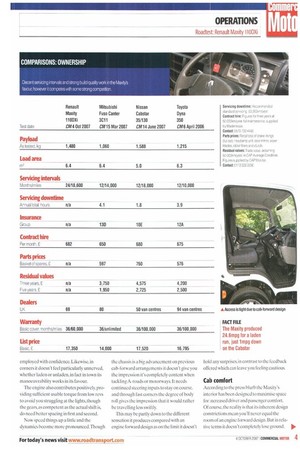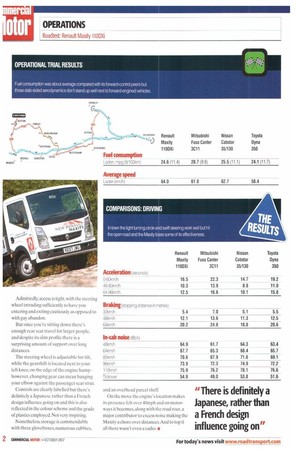"The reduced cab length allows for a longer loadbed than for a comparable enginefonNard vehide"
Page 39

Page 40

Page 41

Page 42

If you've noticed an error in this article please click here to report it so we can fix it.
works) down on its Nissan Cabstar cousin.
In fact all the comparison cab-forward CVs failed to puncture the 30rnpg mark. Compare that to Volkswagen'sTransporter dropside which came in at 32.6mpg for a laden run. Of course there are benefits to be had with this set-up.The reduced cab length allows for a longer loadbed (3,660mm in this case) than for a comparable engine-forward vehicle.
And the turning circle is equally competitive, working at out 4.8m kerb-to-kerb,a class-leading figure according to Renault, and most useful when manoeuvring on building sites and the like.
The drop-side body is provided by Scattolini and is a mixture of aluminium side panels and steel base. Access is via pull-out plastic handles that operate with enough give to allow swift opening, with the rear panel incorporating a fold-down step to aid hopping up onto the load area.
There's also a slip-resistant resin surface that grips the payload soundly enough, though for further security tie-down points situated along the edge of the platform are included.
On the road
For every positive there's a negative, so for that compact turning circle and competitive load bed sizing you also have to deal with the engine and steering wheels situated directly below your rear, and though larger trucks are happily productive with this arrangement in the Maxity's case there is an alternative in the form of an engine-forward design.
At low speeds it behaves passively with driver inputs such as steering and braking employed with confidence. Likewise, in corners it doesn't feel particularly unnerved, whether laden or unladen, in fact in town its manoeuvrability works in its favour.
The engine also contributes positively, providing sufficient usable torque from low revs to avoid you struggling at the lights, though the gears, as competent as the actual shift is, do need better spacing in first and second.
Now speed things up a little and the dynamics become more pronounced Though the chassis is a big advancement on previous cab-forward arrangements it doesn't give you the impression it's completely content when tackling A-roads or motorways. It needs continued steering inputs to stay on course, and through fast corners the degree of body roll gives the impression that it would rather he travelling less swiftly.
This may be partly down to the different sensation it produces compared with an engine forward design as on the limit it doesn't hold any surprises, in contrast to the feedback offered which can leave you feeling cautious.
Cab comfort
According to the press blurb the Maxity's interior has been designed to maximise space for .i-icreased driver and passenger comfort. Of course, the reality is that its inherent design constrictions mean you'll never equal the room of an engine forward design. But in relative terms it doesn't completely lose ground, Admittedly, access is tight, with the steering wheel intruding sufficiently to have you entering and exiting cautiously as opposed to with gay abandon.
But once you're sitting down there's enough rear seat travel for larger people, and despite its slim profile there is a surprising amount of support over long distances.
The steering wheel is adjustable for tilt, while the gearshift is located next to your left knee, on the edge of the engine hump however, changing gear can mean banging your elbow against the passenger seat strut.
Controls are clearly labelled but there's definitely a Japanese, rather than a French design influence going on and this is also reflected in the colour scheme and the grade of plastics employed. Not very inspiring.
Nonetheless, storage is commendable with three gloveboxes, numerous cubbies, and an overhead parcel shelf.
On the move the engine's location makes its presence felt over 40mph and on motorways it becomes, along with the road roar, a major contributor to excess noise making the Maxity a chore over distances. And to top it all there wasn't even a radio.


























































































































































































